Turning To Ultra-High Concentrations To Increase The Competitiveness Of CPV

In solar circles, if you want to generate some positive publicity, there is little that can beat the breaking of the solar efficiency record.
It is easy to understand why such success can hit the headlines. It is partly because the breaking of a record is a clear success story "“ and it is also because solar technology is rather pricey, and gains in efficiency promise to allow it to be far more competitive with the likes of coal, oil and gas.
However, boosting efficiency is not the only way to bring down the cost of solar energy generation, and in the case of concentrating photovoltaics (CPVs), there are two other levers that can deliver far greater gains. One route for slashing costs is to move to ultra-high levels of concentration "“ that is, 1000 suns or more "“ and the other is to increase manufacturing volumes and streamline production.
Championing the adoption of both these approaches is Carlos Algora, Head of the III-V Semiconductors Group at the Solar Energy Institute of the Technical University of Madrid (IES-UPM). Thanks to the efforts of him and his team, those working in this field can benefit from calculations for determining how the cost of electrical generation for CPV systems depends on efficiency, the level of concentration, and a factor that Algora refers to as "˜learning'.
The latter factor, "˜learning', encompasses a variety of cost-reducing mechanisms. They include the fall in costs that occurs as manufacturing ramps up, and engineers involved with this introduce new approaches for cutting costs "“ and learning also includes the trimming of costs that result from the use of mass production plants and the negotiation of attractive discounts from suppliers.
Calculations including all of these factors are carried out by considering a starting point of low-volume production, such as 1 MW, and efforts are made to determine how far costs will fall as production climbs to far higher values, such as 1 GW.
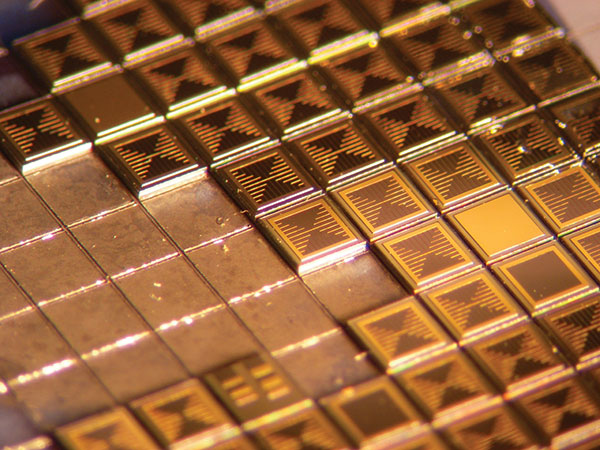
1 mm2 GaInP/GaInAs/Ge triple-junction solar cells developed by the III-V Semiconductors Group of IES-UPM. Calibrated efficiency of these devices is 39.2 percent.
"What is important is that we apply different learning coefficients depending on the components of the CPV system," argues Algora. This means that learning associated with optoelectronics is applied to secondary optics, while the learning of motors and related components is used for trackers.
The most recent set of calculations by Algora and his co-workers have determined the dividends paid by learning, higher concentrations and increasing efficiency. To judge the level of cost reduction, keep in mind a baseline figure "“ installation costs of 2.40 Euro-per-Watt-peak for a 500 suns CPV plant of one megawatt employing 36 percent efficiency cells.
Increasing cell efficiency will obviously bring this installation cost down, but even raising efficiency to a jaw-dropping 50 percent − 4 percent above today's efficiency record "“ will only deliver a fall in costs to 1.75 Euro-per-Watt-peak, according to the calculations. Such gains are possible just through learning, however, and if concentration is increased to 1000 suns, it is possible to do even better, reaching Euro-per-Watt-peak values of 1.30-1.45. But most encouraging of all, if the three levers of efficiency, concentration and learning are pulled in unison, it is possible for post-learning generation costs to nudge 0.8 Euro-per-Watt-peak at 1000 suns.
Look carefully at these calculations and you will find a hierarchy of factors influencing the cost of CPV: first learning, second the level of concentration, and third efficiency. But the bad news is that the factor that can deliver the biggest benefit, learning, cannot be the initial driver to lower costs. That's because it will only be possible to draw on the benefits of learning by first increasing demand for CPV, which must be spurred by moves to higher efficiencies and concentrations.
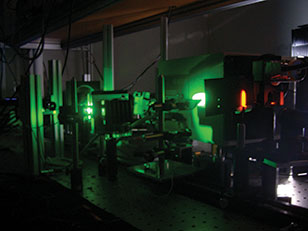
The characterization setup at IES-UPM for measuring the electro-optical properties of multi-junction solar cells
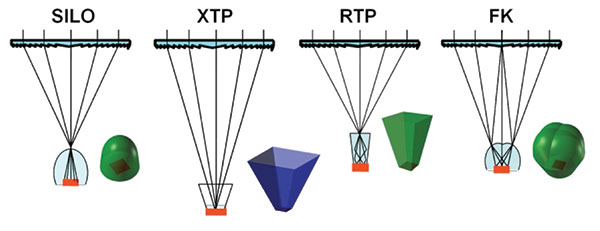
Diagonal cross sections of different CPV systems with secondary optics elements. From left to right: Secondary lens producing Köhler integration with 1-fold (SILO), truncated inverted pyramid mirror (XTP), truncated inverted pyramid glass (RTP) and secondary lens delivering Köhler integration with 4-fold (FK). All the elements have been simulated with the 3D distributed model of IES-UPM.
Although the benefits of moving to higher concentrations are clear from these calculations, naysayers may argue that there are many reasons why greater focusing of the sunlight is not a great idea. They might point out that ultra-high concentrations would make it very tricky to construct a stable multi-junction cell that would not overheat and would provide a sufficiently low series resistance. And they might also claim that increasing the level of concentration would place very challenging demands on the pointing accuracy for the focusing of the sunlight "“ after all, the most widespread CPV system built by Soitec, which operates at 500 suns, has an acceptance angle of about 0.5 degrees.
Algora and his co-workers are rebuffing these criticisms by designing and manufacturing new cells that work better at high concentrations. They are designed to work with already available high-performance focusing elements for ultra-high concentrations, such as those developed by LPI. "The market is dominated by the classical Fresnel lens, which is not specifically developed for CPV," argues Algora.
With more appropriate optics, an acceptance angle of around 1 degree at concentrations of 1000-2000 suns is possible. The rub is a move to two-stage optics, but even this has an upside: With secondary optics, an optical element covers the cell, protecting it from the environment, so reliability is further increased.
Another advantage of introducing a new optical design is that it can improve the level of uniformity of concentration impinging on the cell. Algora says that about ten years ago the situation was terrible, with non-uniformity (peak-to-average) factors of typically four or five at ultra high concentrations. Currently, this situation has improved with peak-to-average factors of now about 1.5-2.0. This means that when optics are purchased today for building CPV modules operating at 1000 suns, at the centre of the cell the level of concentration can be 1.5-2.0 times this. And that is a problem, because many of the cells designed to operate at 1000 suns have an efficiency that drops off a cliff, rather than slowly decreasing at higher values.
What's more, champion cells rarely give their best at 1000 suns: Soitec's 46 percent efficiency four-junction, wafer-bonded cell produced its best performance at 508 suns, while Sharp's inverted metamorphic structure delivered its peak efficiency of 44.4 percent at 302 suns and Spire's device topped out at 42.3 percent at 406 suns. However, a peak efficiency at higher concentrations is possible. For example, the West-coast start-up Solar Junction has produced triple-junction devices delivering
44 percent efficiency at 947 suns, and the IES-UPM team has produced even higher values for concentration at peak efficiency with cells sporting fewer junctions: it has reported 26.2 percent efficiency at 1004 suns for a GaAs single-junction solar cell and 32.6 percent efficiency at 1026 suns for a GaInP/GaAs dual-junction solar cell.
To those that believe over-heating of the cell could be a concern at ultra-high concentrations, Algora counters by pointing out that if the cell is small enough, there isn't even the need for active cooling. According to him, at 1000 suns the light power density impinging on the cell is 1 MW/m2, so for a cell with a surface area of 1 mm2, incident power is just 1 W. If 40 percent of this energy is converted into electricity, that leaves 600 mW generating heat, which is easy to extract.
With small cells, one big issue today is laying hands on product. Algora says that in the brochures of the main solar cell manufacturers, the smaller solar cells are 5 mm by 5 mm or 3 mm by 3 mm. Such cells are designed to operate at 500 suns, which represents the biggest market for CPV, and in this realm thermal management is not such an issue. However, as more CPV system makers move to ultra-high concentrations, availability of smaller cells should rise.
Moving to concentrations of 1000 suns or more places additional demands on the tunnel-junctions connecting the cells. These current-carrying bridges must not limit the flow of charge through the cells, so they should ideally have a peak current density in excess of 30 A cm-2 "“ this capability can accommodate currents associated with concentrations of up to 2,000 suns. While offering this level of performance, the voltage drop across the tunnel-junction should be as small as possible, in order to realise as high an efficiency as possible
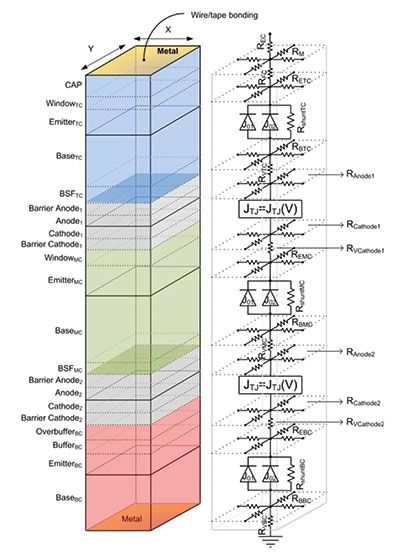
The structure of a triple junction solar cell unit under the front contact (left figure) and the corresponding 3D distributed model (right figure) developed at IES-UPM.
Orchestrating efforts to develop a high-quality tunnel junction is Algora's colleague, Enrique Barrigón. He explains that the material used to make the tunnel-junction governs the peak current density. "In order to have high peak current densities, you should use low bandgap materials, but that introduces a limitation into your design." That limitation is light absorption, which drags down cell efficiency of the subcell beneath the tunnel junction.
It is possible to overcome this conundrum with a special tunnel junction designed by the IES-UPM team that is built from the pairing of p-type, heavily doped AlGaAs and n-type, heavily doped GaInP. "It has a very high peak current density, and at the same time it is transparent for the light going into the middle cell."
To reach such a high current density "“ it is initially 996 A cm-2, and falls to 235 A cm-2 after a thermal annealing step that simulates the growth of additional sub-cells "“ traps must be present in the structure. "If you try to simulate the behaviour of your tunnel junctions, it is impossible to get such high peak current densities unless you introduce some trap defects that enable the tunnelling," explains Barrigón.
Optimisation of the multi-junction solar cell also requires optimisation of other aspects of the device, such as the contacts. Algora and his team have been active in this area, developing a three-dimensional distributed model that simulates the operation of the solar cell at real conditions.
"It is compulsory to go towards a distributed model, because inside a concentrator the solar cell experiences unhomogeneous illumination in terms of intensity, chromatic aberration, etc," explains Algora. Due to these differences, there are variations in voltage losses and photocurrents, but with the distributed model it is still possible to optimise the design of the front metal grid, current matching among the subcells and the solar cell dimensions. "It is a very useful model when you go towards the real world," claims Algora.
While undertaking all this work, the Spanish academic has been a vehement campaigner for improving the manufacturing process. Since 1997 he has been advocating a move to an LED-like approach to making CPV cells and modules that will allow a trimming of the cost of this technology. He holds a Spanish patent related to this that was granted in 2000, and he and his team have collaborated with Semprius, a pioneer of ultra-high concentrations that employs 1,111 suns on cells with sides of 0.6 mm (see Compound Semiconductor, July 2014, p. 34).
Algora believes that the LED industry can offer some insights into multi-junction reliability. Both species of device may incorporate similar III-V materials, and with lifetimes of 50,000-100,000 hours, the reliability of the LED is encouraging for the future of CPV.
Giving rise to further optimism, current densities in LEDs are higher than those in multi-junction cells operating at ultra-high concentrations. However, there is good reason for caution at this stage: Since CPV systems need to operate for 30 years or more, the cells must have lifetimes around two times that of LEDs.
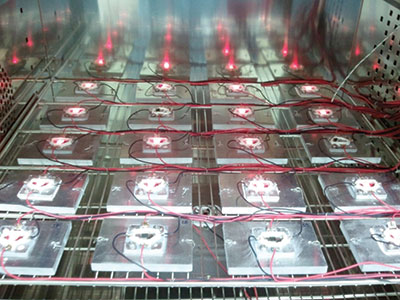
A temperature-accelerated life test of commercial triple solar cells carried out at IES-UPM to assess the reliability of the devices.
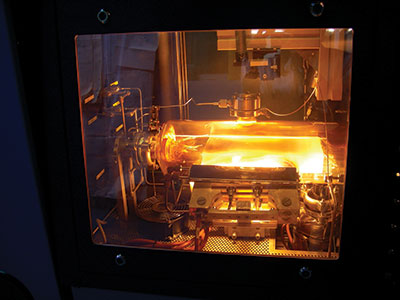
The MOCVD reactor at IES-UPM.
While there are compelling arguments for strong growth of a CPV industry sporting ultra-high concentrations, Algora believes that will not happen overnight, with success hinging on both the future of the PV industry at large, and the CPV industry operating at more modest concentrations. "We have the technology in the main components "“ solar cells, optics, trackers and modules "“ and we have a very brilliant future regarding improvement in all of these aspects, mainly solar efficiency," argues Algora.
However, for sales to rise, he believes that the cost of the technology must drop to less than that associated with silicon flat-plate technology (he says that today the cost of CPV should be as little as 20-30 percent more expensive than silicon if installed in places with 20-30 percent higher direct irradiance than those usually used for silicon systems).
The fastest way for CPV to close the gap with silicon is learning, and according to Algora, learning means production of close to half a gigawatt, or a gigawatt. At present the only companies able to do that are Soitec and Suncore, so for the benefits of learning to materialise, shipments of CPV systems from these companies must climb over the next years.
If Soitec and Suncore are successful, this will allow companies with different approaches to CPV to make an impact, including those pioneering ultra-high concentrations. "These new actors will benefit from a lower price of trackers and a low price of optics," says Algora.
"But now, CPV is in the hands of these two biggest companies, so we would very much like the success of these two companies."































